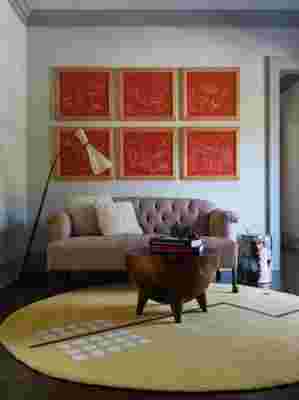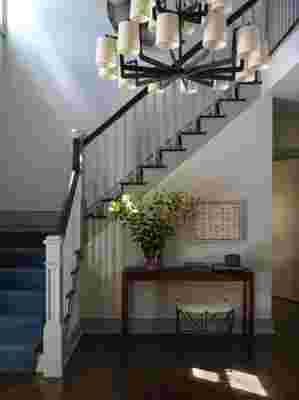“Starting with beautiful objects and putting them together in a way that's a bit off, that creates some kind of tension—it adds to the power of each object,” says Ryan Lawson, summing up his design philosophy and the leitmotif of his latest project, a Shingle-style vacation home near the town of Sag Harbor, in the Hamptons. Given free rein by his clients, the designer decided to respect the traditional architecture of the house but to also “create a story” that was attuned to the sensibilities of its dwellers, a Manhattan couple with an appreciation for contemporary art and vintage furniture. The result is both timeless and vibrant. Each room in the five-bedroom, two-story property displays an unexpected yet seemingly effortless combination of classic, midcentury, and Art Deco furnishings, complemented by sculptural light fixtures and abstract paintings.

“I didn’t like the idea of a breakfast room being visible from the foyer, so I decided to make it a sitting room,” says Lawson of this corner space in the kitchen. “It’s the most popular seat in the house.” The rolled-arm tufted sofa is from BDDW ; its classic silhouette offers a nice contrast to the modern pot-bellied table, made out of a single walnut trunk by sculptor Kieran Kinsella , and the round Art Deco–style rug from Beauvais Carpets .
Lawson, who studied art at Washington University in St. Louis before opening his interiors studio in New York City in 2005, says he likes to give himself some leeway in the process of designing a space, to let his imagination flow and make room for improvisation. In this case, he found inspiration in the lush and peaceful landscape surrounding the property, a two-acre garden brimming with hydrangea, myrtle, and lavender, with woodlands as far as the eye can see. “I wanted to create something very inviting that felt appropriate to where the house is located,” he recalls, “and give it some soul.”
He started by commissioning a series of thick hand-hooked rugs to add texture, then headed to some of his favorite antiques dealers to buy items “with patina and stories,” including a French folding screen from the 1920s, made of maplewood and plaster; a Pietro Chiesa glass coffee table from the 1930s, which survived a war without a single chip; and a Guglielmo Ulrich slipper chair from the ’40s. Improvisation notwithstanding, Lawson was very intentional about putting together a striking collection of vintage Italian lamps and chandeliers, seen throughout the house. He also helped his clients choose a series of abstract artworks featuring vivid colors and geometric shapes. “The art is slick and contemporary,” says the designer. “Hopefully it energizes all of the older components and gives the space a ‘now’ quality.”


The ultimate resource for design industry professionals, brought to you by the editors of Architectural Digest
Lawson’s distinct approach to design—his ingeniously arranged salmagundi of styles—is evident in the home’s living room, where a classic tufted armchair and ottoman was paired with a rustic leather-and-oak coffee table, designed circa 1955 by Jacques Adnet, and an ultramodern mirrored wall sculpture by Michael Anastassiades. “It was a new, empty house, so it felt like there were lots of directions we could have gone,” says the wife, who spends most weekends in the house with her husband, and sometimes also their college-age son. “Working through the process with Ryan, though, helped us to make choices that we didn't have to second-guess. In the end, it feels like this house shouldn't look any other way.”
